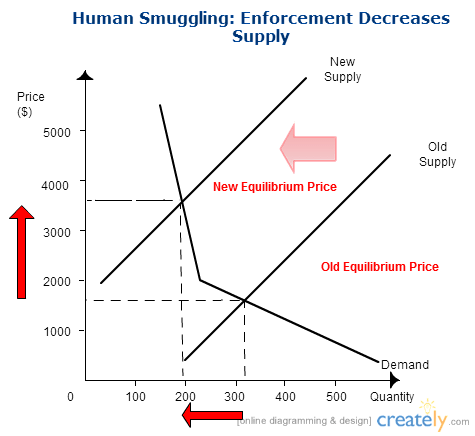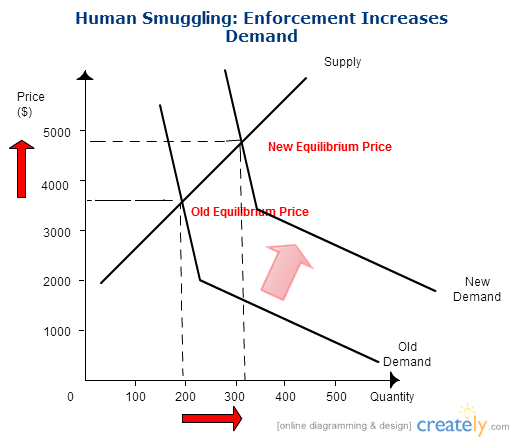The increase of human smugglers transporting unauthorized immigrants to the United States is likely a consequence of more effective border enforcement. Although the Obama administration has de-emphasized internal immigration enforcement after 2011, his administration has ramped up enforcement along the border – focusing on increasing the legal and economic costs imposed on unlawful immigrants apprehended while trying to enter the United States. Since border and internal enforcement are substitutes, the shift in resources and increase in penalties for unlawful crossers does not represent a decrease in total enforcement. Matt Graham from the Bipartisan Policy Center wrote an excellent breakdown of the reprioritization of immigration enforcement, the increase in penalties, and how it has deterred unauthorized immigration.
The price of smuggling is an indication of the effectiveness of immigration enforcement along the border. The first effect of increased enforcement is to decrease the supply of human smugglers. As the supply of human smugglers decreases, the price that remaining human smugglers can charge increases. Before border enforcement tightened in the early 1990s, migrants typically paid about $725 (2014 dollars). Currently, unauthorized migrants from Central America are paying around $7500.
The kink in the human smuggling demand curve represents a hypothesized increase in inelasticity for certain consumers of human smuggling. The inelastic portion of the demand curve represents consumers who very much want to come to the United States and who will pay a very high price to do so. For that group, an increase in price does not much decrease their quantity demanded for human smuggling. For the relatively elastic portion of the demand curve, a small rise in price causes a large drop off in the quantity demanded for human smuggling. The increase in enforcement has shifted the supply curve to the left, pricing the immigrants with a relatively elastic demand for human smuggling out of the market while raising the price on the inelastic demanders.
The immigrants most likely to have inelastic quantity demand for human smuggling are those fleeing violence or seeking to reunite with their families in the United States. An increase in smuggling price will not much decrease the quantity of smuggling demanded by parents seeking to reunite with their children and children fleeing the threat of death. Smugglers know that children reuniting with their families and those fleeing violence are the most likely to pay high prices, thus the smugglers have focused on recruiting those groups as customers – one large reason why so many unaccompanied children (UAC) are transported to the border by smugglers.
Another result of more effective immigration border enforcement is that it increases immigrant reliance on human smugglers. Unauthorized immigrants who used to walk across the border when immigration enforcement was light now increasingly rely on human smugglers to avoid detection. The crackdown on unauthorized immigrants, especially after 1993, caused a big increase in the use of smugglers by unauthorized immigrants. In 1999, 3.2 percent of apprehended unlawful immigrants reported hiring a human smuggler. In 2008, 18 percent of apprehended unlawful immigrants reported hiring a human smuggler – an almost six-fold increase. The Department of Homeland Security (DHS) and private organizations have also noted an increase in the price of smuggling.
From 1972 to 2003, a 10 percent increase in the number of border patrol enforcement hours increases the price that smugglers can charge by 2.5 to 3.8 percent. Line watch hours have grown by over 400 percent since the early 1990s.
The economics of industrial organization can shed some light on why smugglers have shifted from mom and pop operations to large, organized, and violent criminal cartels who now seek children clients instead of adults. Mom and pop smugglers ran small and unsophisticated operations to smuggle immigrants over the border. As border patrol cracked down on them and put many out of business, more intensive smuggling operations that required more capital, planning, and violence to overcome enforcement were needed to satisfy the demand. As a result of the shrinking mom and pop smuggling operations, serious criminal organizations and drug gangs have become specialized in smuggling migrants because of the higher profits. The shift from mom and pop smugglers to sophisticated criminal smugglers that focus on smuggling those with an inelastic demand for smuggling is the result of larger and more effective border enforcement.
Another consequence of higher smuggling prices is that migrants have to work for a longer period of time in the United States to justify the larger financial cost of immigrating. As a result, migrants do not return to their home countries as frequently and many end up making the United States their permanent home. This also incentivizes unlawful immigrants to send for their children after they arrive in the United States – further increasing the quantity demanded for smuggling.
More intensive and expanded border enforcement can explain part of the increased reliance of UAC on human smuggling. And just because it is not obvious to some – the number of UAC in custody is a result of effective immigration enforcement along the border. The surge in UAC is portrayed by many immigration restrictionists as a failure of immigration enforcement. Those commentators should realize that the shift toward human smugglers is evidence that increased border enforcement is decreasing unauthorized immigration. Immigration restrictions are not immune from the law of unintended consequences.


